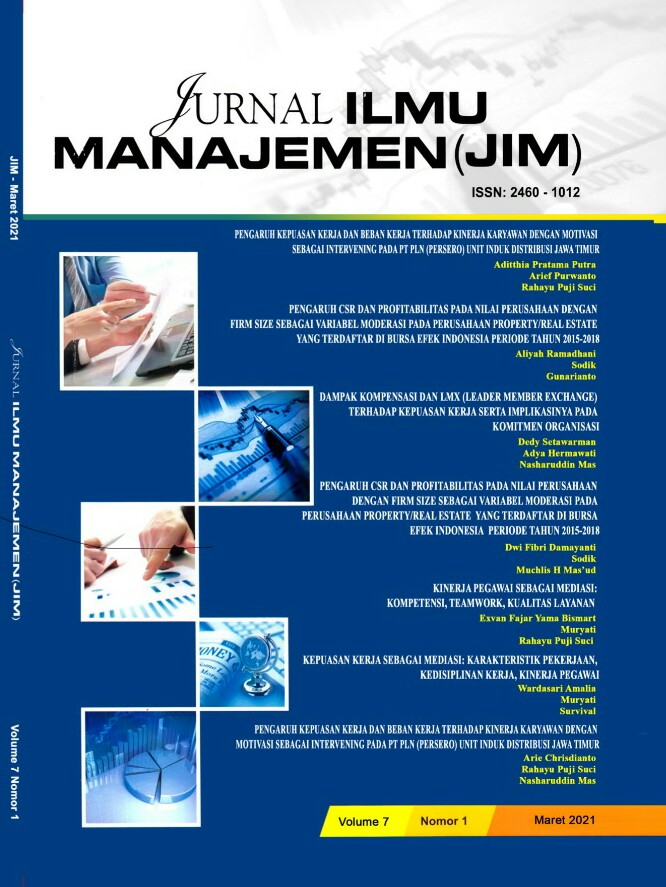PENGARUH KEPUASAN KERJA DAN BEBAN KERJA TERHADAP KINERJA KARYAWAN DENGAN MOTIVASI SEBAGAI INTERVENING PADA PT PLN (PERSERO) UNIT INDUK DISTRIBUSI JAWA TIMUR
DOI:
https://doi.org/10.31328/jim.v7i1.2541Keywords:
Kata Kunci, kepuasan kerja, beban kerja, motivasi, kinerja karyawanAbstract
ABSTRACT  This study aims to analyze how an organization in improving the performance of its employees through job satisfaction, workload and motivation. The research object chosen was the employees of PT PLN (Persero) the Main Distribution Unit of East Java. This type of research includes causality research, the sampling method uses Proportionate Stratified Random Sampling, hypothesis testing and to produce a suitable model (fit), the number of samples is 228 employees at PT PLN (Persero) the Main Distribution Unit of East Java. This study uses the Structural Equation Model (SEM), with the Partial Least Square (PLS) approach. The results of this study obtained a conclusion where job satisfaction, workload and motivation have a direct and significant influence on employee performance. Keywords: job satisfaction, workload, motivation, employee performance ABSTRAK  Penelitian ini bertujuan untuk menganalisa bagaimana sebuah organisasi dalam meningkatkan kinerja karyawannya melalui kepuasan kerja, beban kerja dan motivasi. Objek penelitian yang dipilih adalahkaryawan di PT PLN (persero) Unit Induk Distribusi Jawa Timur.Jenis penelitian ini termasuk jenis penelitian kausalitas, metode pengambilan sampel mengunakan Proportionate Stratified Random Sampling, penguji hipotesis dan untuk menghasilkan suatu model yang layak (fit),jumlah sampel 228 orang karyawan di PT PLN (persero) Unit Induk Distribusi Jawa Timur. penelitian ini mengunakan Structural Equation Model (SEM), dengan pendekatan Partial Least Square (PLS) hasil penelitian ini didapatkan sebuah kesimpulan dimanakepuasan kerja, beban kerja dan motivasi memiliki pengaruh secara langsung dan signifikan terhadap kinerja karyawan. Kata Kunci: kepuasan kerja, beban kerja, motivasi, kinerja karyawan ÂReferences
Daftar Pustaka
Alamsyah, (2012). “Manajemen Pelayanan Kesehatanâ€. Yogyakarta: Nuha Medika.
Anik, L., 2013 Prosocial Bonuses incrase employee satisfaction and team performance.Plos one.
A, Shadare, Oluseyi, dan Ayo, Hammed T. (2009). Influence of work motivation, Leadership Effectiveness And Time Management of Employees Performance in Some Selected Industries in Ibadan, Oyo State, Nigeria. European Journal of Economics, Finance and Administrative
Augusty, Ferdinand. 2015. Metode Penelitian Manajemen: Pedoman Penelitian untuk Penulisan Skripsi, Tesis, dan Disertasi Ilmu Manajemen. Edisi 3, AGF Books, Fakultas Ekonomika dan Bisnis Universitas Diponegoro, Semarang.
Armstrong, M and Baron, A. 1998.Performance Management- The new Realities.London : Institute of Personnel and Development.
Armstrong, M And Taylor, S. 2009. Armstrong’s Handbook of Human Resource Management Practice.Kagon page Publisher.
Barney,J.B. 2010. Gaining and Sustaining Competitive Advantage, Fourth Edition. AddisonWesley, Massachusetts.
Bernadin & Russel. 1993. Human Resource Management, New Jersey : International Egitions Upper Saddle River. Prentice Hall.
Gibson, James L. et al. (1996). Organisasi: Perilaku, Struktur, Proses. Diterjemahkan oleh Ninuk Adriani. Jakarta: Binarupa Aksara.
George dan Jones, 2005, Understanding and Managing Organizational Behavior 4th Edition, Pearson Prentice Hall.
Gomes, Faustino Cardoso. (2000) Manajemen Sumber Daya Manusia, Cetakan Keempat. Yogyakarta. Penerbit Andi
Dassler, Gary. 2009. Human Resources Mangement, Precentine Hall.
Dessler, 1997, Manajemen Sumber Daya Manusia Human Reources, Jilid 2, Prenhalindo, Jakarta.
Flippo, Edwin. 1996. Manajemen Personalia Edisi 2.Jakarta : Erlangga.
Hani Handoko T. 2008 .Manajemen Personalia dan Sumber Daya Manusia, Edisi Dua, BPFE, Universitas Gajahmada, Yogyakarta.
Hair, J.F., Black, W.C., & Babin, B.J. 2014.Multivariate Data Analysis.New International Edition. New Jersey: Pearson.
Komarudin, Ahmad. 1996. Dasar-dasar Manajemen Investasi. Jakarta: Renika Cipta.
Luthans, F. 2011. Organizational Behavior, an evidencie-based approach (12,ed), McGraw Hill, Boston.
Mathis, R.L, dan Jackson, J. 2011. Human Resource Management: essential Perspective. Cengage Learning.
Peraturan Direksi PT PLN (Persero) Nomor 0045.P/DIR/2017 Tentang Sistem Manajemen Kinerja Pegawai
Rivai et al,. 2015. Manajemen Sumber Daya Manusia untuk Perusahaan Edisi ke 7, Depok : PT. RAJAGRAFIINDO.
Robbins, Stephen P. 2010, Perilaku Organisasi ,edisi ke – 10, Cet 11. PT Indek.
Robbins dan Judge. 2008, Perilaku Organisasi Buku 2, Jakarta : Salemba Empat.
Robbins, Stephen P.dan Coulter Mary 2010. Manajemen edisi ke sepuluh Jakarta: Penerbit Erlangga.
Singarimbun M. & Effendi S.1995.Metode Penelitian Survai, Cetakan kedua, PT. Pustaka LP3ES, Jakarta.
Shah, Syed Saad Hussain.Et al. (2011).Workload and Performance of Employees.Interdisciplinary Journal of Contemporary Research in Business.Ijcrb.
Spector. (1997). Job satisfaction: Application, assessment, causes and consequences,Thousand Oaks, CA,Sage Publications, Inc
Sugiyono, 2001. Metode Penelitian, Bandung: CV Alfa Beta.
Wallach, Ellen J. 1983. “Individuals and Organizations: The Cultural Matchâ€. Training and Development Journal, pp. 29-36.
Downloads
Published
Issue
Section
License
.png)
Attribution — You must give appropriate credit, provide a link to the license, and indicate if changes were made. You may do so in any reasonable manner, but not in any way that suggests the licensor endorses you or your use.
ShareAlike — If you remix, transform, or build upon the material, you must distribute your contributions under the same license as the original.Â
 ========================================
The Copyright Transfer Form can be downloaded here:Â [Copyright Transfer Agreement Widya Yuridika]Â
The copyright form should be signed originally and send to the Editorial Office in the form of original mail or scanned document toÂ
Editor-in-Chief
Jurnal Ilmu Manajemen
Postgraduate Program, Masters of Management, Universitas Widya Gama, Malang.

